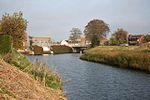Deeping St Nicholas
Civil parishes in LincolnshireSouth Holland, LincolnshireThe DeepingsVillages in LincolnshireWind farms in England

Deeping St Nicholas is a village in Lincolnshire, England, on the A1175 road between The Deepings and Spalding. Unlike Market Deeping, which is in South Kesteven district, Deeping St Nicholas is in South Holland. Deeping St Nicholas is also a South Holland civil parish which includes the small settlements of Tongue End and Hop Pole, and a number of outlying farms. Its population at the 2011 census was 1,961.
Excerpt from the Wikipedia article Deeping St Nicholas (License: CC BY-SA 3.0, Authors, Images).Deeping St Nicholas
Littleworth Drove, South Holland Deeping St. Nicholas
Geographical coordinates (GPS) Address Nearby Places Show on map
Geographical coordinates (GPS)
| Latitude | Longitude |
|---|---|
| N 52.7284 ° | E -0.20205 ° |
Address
Littleworth Drove
Littleworth Drove
PE11 3EN South Holland, Deeping St. Nicholas
England, United Kingdom
Open on Google Maps









